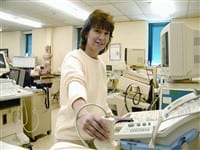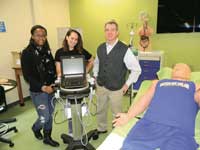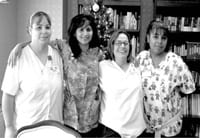View To The Future The Fluid Dynamics Of Sonography
Editor’s Note: This is the first in a series of stories that will explore emerging professions in health care.
As a licensed practical nurse at Berkshire Medical Center (BMC), Linda Litano was exposed to dozens of different careers in health care. One that really caught her eye — and her attention — was diagnostic medical sonography, the use of ultrasound.
“The technology — and what you do with it — is simply amazing,” said Litano, who is now in her first semester of work
in the associate’s degree program in Sonography at Springfield Technical Community College (STCC). “There is so much to do in this field, and the technology is always improving.”
Litano is enrolled at STCC as part of a unique program at BMC, in which the medical center picks up the tab for those employees willing and able to acquire the additional skills needed to assume jobs in fields where there are critical shortages of trained personnel. The fact that ultrasonography falls into this category — coupled with Litano’s eagerness to enter the field — speaks volumes about the state of this intriguing health care profession.
Indeed, ultrasound is being used in many more ways than it was only a few years ago, said Avis Vincensi, RDMS, associate professor and chair of STCC’s sonography program. A 25-year veteran of the industry, she has seen the technology come in waves — literally and figuratively — and evolve from still pictures of organs and tissue to the equivalent of motion pictures that can be used for everything from monitoring a fetus in utero to detecting and treating heart disease.
However, this profound growth in the use of ultrasound technology has yet to be matched by a critical mass of trained, registered technicians, said Vincensi. This explains why she’s getting so many calls from recruiters asking about soon-to-be graduates of the STCC program.
“I get calls from facilities across the country,” she explained. “Sonographers are in great demand, and the need will only grow in the future.”
Students in the STCC course of study, the only accredited program of its type in Western Mass., usually have jobs locked in well before they graduate, said Vincensi. She told The Healthcare News that current accreditation terms — and available resources, including faculty — limit the size of each graduating class to 10 students.
To increase this number, she is currently exploring several options, including partnerships with area health care providers that are directly impacted by the shortage of sonographers. To ease an ongoing nursing shortage, area hospitals have helped fund programs at area colleges and UMass, Vincensi explained, adding that a similar arrangement in the sonography field may be possible.
For the immediate future, providers will have to compete for a limited number of professionals, which should create a wealth of opportunities for those entering the field.
Making Waves
Vincensi described sonography as a blend of science and art.
The science, of course, is the use of high-frequency sound waves (ultrasound) to produce images — in this case, of organs, tissue, or blood flow inside the body. The art, meanwhile, involves just how that science is used to help health care professionals make accurate diagnoses and prescribe treatment.
“People in this field have to be logical, but they also have to be creative — we’re creating images,” she explained. “It’s hard to get that combination in an individual, but that’s what we look for.”
Sonographers create these images through the use of a device known as a transducer, which is placed against the patient’s skin near the area to be imaged and moved across that area to gain the information needed for a diagnosis, said Vincensi. The transducer works like a loudspeaker and a microphone, because it can transmit sound and receive sound. It sends a stream of high-frequency sound waves into the body that bounce off the structures being analyzed. Different structures in the body reflect sound waves differently, she said, noting that the sounds are analyzed by a computer to make an image of the structure on a television screen.
Perhaps the best-known use of sonography is ultrasound testing to monitor the progress of a fetus. But there are several areas of specialization within the field, such as:
- The Abdomen — evaluation of all the soft tissues, blood vessels, and organs of the abdominal cavities (for example, liver, spleen, urinary tract, and pancreas;
- The Breast — sonography is frequently used to evaluate breast abnormalities that are found with screening or diagnostic mammography;
- Obstetrics/Gynecology — evaluation of the female reproductive system;
- Echocardiography — evaluation of the anatomy and hemodynamics (blood flow) of the heart, its valves, and related blood vessels;
- Vascular Technology — evaluation and analysis of the hemodynamics (blood flow) of peripheral and abdominal blood vessels;
- Neurosonography — evaluation of the brain and spinal cord; and
- Ophthalmology — evaluation of the eyes, including orbital structures and muscles.
Individuals are moving into the field in increasing numbers, said Vincensi, noting that most start as generalists and later, through additional training, become a specialist in echocardiography, breast ultrasound, and other areas.
Students at STCC blend classroom work with hands-on experience at one of eight clinical sites in Western Mass. and Northern Conn. The college has affiliated with several area hospitals to create clinical opportunities, and has requests to establish new partnerships.
Vincensi said individuals are drawn into field for a variety of reasons. Some are lured by the high degree of interaction with patients, while others are intrigued by the attractive wage scales — technicians are starting at close to $20 an hour and can do much better.
There are usually about 100 applicants for each class of 10, she said, and there is great diversity within those groups. About 20 to 30 of the applicants are recent high school graduates, while most others are older individuals looking for a career change. Some, like Litano, are already working in health care and are looking for a different kind of challenge.
“Ultrasound is right up my alley — I’m a hands-on person and I love interaction with patients,” she said. “Ultrasound gives me that interaction, more so than X-ray work would; you’re with the patient the whole time.”
Litano said she has been intrigued by sonography for some time, and was urged by a friend to attend a one-year program in the field. Her children were much younger then, she explained, and thus the timing wasn’t right. It is now, though, and the BMC program makes it that much easier to make a career change.
Vincensi said the challenge for STCC and other schools with sonography programs is to provide enough graduates for hospitals and other facilities that need technicians.
The shortage of sonographers has created challenges for hospitals, and also ome additional expense, she said. Some facilities, for example, must make use of agency sonographers, which, like nurses in that same category, come at a higher pay scale than technicians that are on the staff.
Meanwhile, many health care providers must make use of what Vincensi called ‘traveling sonographers.’ These entrepreneurial individuals are essentially independent contractors who don’t work for one facility, but instead fill vacancies on a temporary basis. Such work is fairly lucrative, she told The Healthcare News, adding that while it is attractive option for sonography students — and she encourages people to explore that option — it is an expensive proposition for providers.
This phenomenon may encourage area hospitals to provide some assistance — financial and otherwise — to STCC, with the goal of expanding its sonography program and producing more technicians.
“This is something we’re exploring,” she said. “Obviously, we’d like to expand our program, but we’re limited in what we can do.”
Sound Logic
Looking down the road, Vincensi said that as the nation’s population ages, there will be career opportunities in a number of health care fields. Sonography will be one of them.
“There is going to be steady demand for qualified people,” she said. “This is a healthy field to be in, and it will only continue to grow.”




Comments are closed.